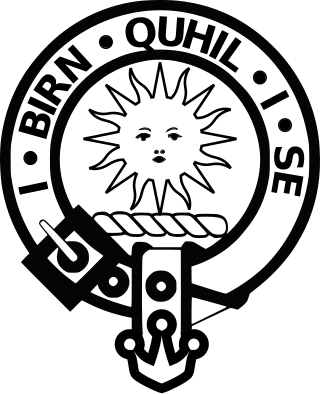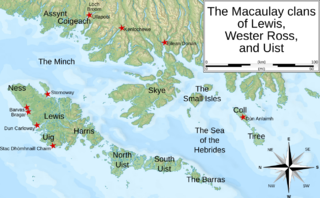Related Research Articles

Lord of the Isles or King of the Isles (Scottish Gaelic: Triath nan Eilean or Rìgh Innse Gall; Latin: Dominus Insularum) is a title of Scottish nobility with historical roots that go back beyond the Kingdom of Scotland. It began with Somerled in the 12th century and thereafter the title was held by a series of his descendants, the Norse-Gaelic rulers of the Isle of Man and Argyll and the islands of Scotland in the Middle Ages. They wielded sea-power with fleets of galleys (birlinns). Although they were, at times, nominal vassals of the kings of Norway, Ireland, or Scotland, the island chiefs remained functionally independent for many centuries. Their territory included much of Argyll, the Isles of Arran, Bute, Islay, the Isle of Man, Hebrides, Knoydart, Ardnamurchan, and the Kintyre peninsula. At their height they were the greatest landowners and most powerful lords after the kings of England and Scotland.

Clan MacLeod of The Lewes, commonly known as Clan MacLeod of Lewis, is a Highland Scottish clan, which at its height held extensive lands in the Western Isles and west coast of Scotland. From the 14th century up until the beginning of the 17th century there were two branches of Macleods: the MacLeods of Dunvegan and Harris ; and the Macleods of the Isle of Lewis. In Gaelic the Macleods of Lewis were known as Sìol Thorcaill, and the MacLeods of Dunvegan and Harris were known as Sìol Thormoid.
Peter Love was an English pirate, said to have been born in Lewes, Sussex. He was the captain of the Priam, and for a time occupied a base on the Isle of Lewis, in the Outer Hebrides, when he entered into an agreement with the Hebridean outlaw Neil MacLeod.

Clan Spens or Spence is a Lowland Scottish clan and is also a sept of Clan MacDuff.
Sir George Lauder of the Bass, Knight, was a cleric, Privy Counsellor, and Member of the Scottish Parliament. He was a legal tutor to Prince Henry.

The Macaulay family of Uig in Lewis, known in Scottish Gaelic as Clann mhic Amhlaigh, were a small family located around Uig on the Isle of Lewis in the Outer Hebrides of Scotland. There is no connection between the Macaulays of Lewis and Clan MacAulay which was centred in the Loch Lomond area, bordering the Scottish Highlands and Scottish Lowlands. The Macaulays of Lewis are generally said to be of Norse origin because of the etymology of their surname and also because of the islands' Viking Age past. However, a recent analysis of the Y-DNA of men with Scottish surnames has shown that a large number of Hebridean Macaulays are of Irish origin. In the 17th century, however, tradition gave the Macaulays an Irish origin. By the end of the 16th century the dominant clan on Lewis was Clan Macleod of The Lewes. Other notable Lewis clans were the somewhat smaller Morrisons of Ness and the even less numerous Macaulays of Uig. The Macaulays were centred in the area surrounding Uig on the western coast of Lewis, and had a deadly, long-standing feud with the Morrisons, whose lands were located on the northern coast around Ness. Today the Lewis surname Macaulay is considered to be a sept name of the Macleods of Lewis. There are two other nearby clans of Macaulays who may, or may not, be connected to the Lewis clan—the Wester Ross Macaulays, and the Uist MacAulays.
Kenneth Mackenzie, the first Lord Mackenzie of Kintail, was a Highland clan chief who secured for himself and his heirs the entirety of the Isle of Lewis in the Outer Hebrides and successfully pursued a bloody feud with the Macdonells of Glengarry.

Sir Lachlan Mór Maclean or Big Lachlan Maclean, was the 14th Clan Chief of Clan MacLean from late 1573 or early 1574 until 1598. Mór or Mor translates as big in English, or magnus in Latin, when added to a name in Scottish Gaelic.

Sir Roderick MacLeod of MacLeod (c1559–1626), also known as Rory MacLeod, was the 15th Chief of Clan MacLeod and one of the most famed and notorious chiefs of that clan.

David Murray, 1st Viscount of Stormont was a Scottish courtier, comptroller of Scotland and captain of the king's guard, known as Sir David Murray of Gospertie, then Lord Scone, and afterwards Viscount Stormont. He is known for his zeal in carrying out the ecclesiastical policy of James VI and I, in which he was effective if crude.
Roderick Macleod, also known as Old Rory, was the chief of Clan Macleod of Lewes in the later half of the 16th century.
Bearasaigh or Bearasay is an islet in outer Loch Ròg, Lewis, Scotland. During the late 16th and early 17th centuries it was used as a pirates' hideout and the remains of various buildings from that period still exist. In the modern era its cliffs are used for rock-climbing.

Sir James Spens was a Scottish adventurer, soldier and diplomat, much concerned with Scandinavian and Baltic affairs, and an important figure in recruiting Scottish and English soldiers for the Thirty Years' War. Raised to Swedish peerage as friherre Jacob Spens.
Sir Lachlan Mackinnon was chief of the Scottish Highland clan Mackinnon and played a prominent part in the troubled and transitional politics of the West Highlands in the early 17th century.
Events from the year 1598 in the Kingdom of Scotland.
The MacLeods of Raasay are a minor Scottish noble family and branch of Clan MacLeod of Lewis. At their height they held extensive lands on the Isle of Raasay. In Gaelic the MacLeods of Lewis were known as Sìol Thorcaill. The Chiefship of Clan MacLeod of Lewis passed to the Raasay branch in the 20th century.
Sir James Sandilands was a courtier to King James VI and I and captain of Blackness Castle
Sir James Anstruther of Anstruther, was a Scottish landowner and courtier.
Robert Jameson was a Scottish shipowner from Ayr.
David Carnegie of Colluthie (1559–1598) was a Scottish landowner and administrator.
References
- ↑ Keay, John & Julia (1994). Collins Encyclopedia of Scotland. HarperCollins. p. 370. ISBN 978-0-00-255082-6.
- ↑ Haswell-Smith, Hamish (1996). The Scottish Islands. Canongate. pp. 240–241. ISBN 978-0-86241-579-2.
- ↑ Lenihan, Pádraig. 2008.Consolidating Conquest: Ireland 1603-1727. Harlow: Longman. Pages 43-44.
- ↑ "Fife Place-name Data :: Fingask". Fife-placenames.glasgow.ac.uk. Retrieved 4 April 2020.
- ↑ David Masson, Register of the Privy Council of Scotland: 1592-1599, vol. 5 (Edinburgh, 1882), pp. 462-3, 467-8.
- ↑ "The register of the Privy Council of Scotland. v.5 1592-1599. - Full View | HathiTrust Digital Library | HathiTrust Digital Library". Babel.hathitrust.org. 22 February 2017. Retrieved 4 April 2020.
- ↑ "Domestic annals of Scotland, from the reformation ... v.0001. - Full View | HathiTrust Digital Library | HathiTrust Digital Library". Babel.hathitrust.org. 29 April 2010. Retrieved 4 April 2020.
- ↑ Thomas Thomson, Acts of the Parliaments of Scotland: 1593-1625, vol. 4 (1816), pp. 248-51.
- ↑ Robert Gordon, Genealogical history of the Earldom of Sutherland (Edinburgh, 1813), pp. 270-1.
- ↑ "Neil Macleod | Hebridean Connections". www.hebrideanconnections.com. Archived from the original on 3 September 2022. Retrieved 15 October 2019.
- ↑ David Masson, Register of the Privy Council of Scotland: 1592-99, vol. 5 (Edinburgh, 1882), p. 478.
- ↑ HMC Salisbury Hatfield, vol. 8 (London, 1899), pp. 322-3.